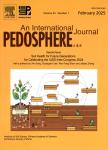Zinc Redistribution in a Soil Developed from Limestone During Pedogenesis
Zinc Redistribution in a Soil Developed from Limestone During Pedogenesis作者机构:INRA UR0272 Science du Sol Centre de recherche d'Orlans 45075 Orlans cedex 2 (France) ISTO UMR 6113 CNRS Universit d'Orlans 45071 Orlans cedex 2 (France) ISTO UMR 6113 CNRS Universitd'Orlans 45071 Orlans cedex 2 (France) IMPMC UMR CNRS 7590 Universit Paris 6 et 7 IPGC 75252 Paris cedex 05 (France)
出 版 物:《Pedosphere》 (土壤圈(英文版))
年 卷 期:2009年第19卷第3期
页 面:292-304页
核心收录:
学科分类:083001[工学-环境科学] 0830[工学-环境科学与工程(可授工学、理学、农学学位)] 08[工学]
基 金:Project supported by the "GDR TRANSMET" Program of the Centre National de la Recherche Scientifique (CNRS) France
主 题:carbonate dissolution eluviation long-term redox speciation
摘 要:The long-term redistribution of Zn in a naturally Zn-enriched soil during pedogenesis was quantified based on mass balance calculations. According to their fate, parent limestones comprised three Zn pools: bound to calcite and pyritesphalerite grains, bound to phyllosilicates and bound to goethite in the inherited phosphate nodules. Four pedological processes, i.e., carbonate dissolution, two stages of redox processes and eluviation, redistributed Zn during pedogenesis. The carbonate dissolution of limestones released Zn bound to calcite into soil solution. Due to residual enrichment, Zn concentrations in the soil are higher than those in parent limestones. Birnessite, ferrihydrite and goethite dispersed in soil horizon trapped high quantities of Zn during their formation. Afterwards, primary redox conditions induced the release of Zn and Fe into soil solution, and the subsequent individualization of Fe and Mn into Zn-rich concretions. Both processes and subsequent aging of the concretions formed induced significant exportation of Zn through the bottom water table. Secondary redox conditions promoted the weathering of Fe and Mn oxides in cements and concretions. This process caused other losses of Zn through lateral exportation in an upper water table. Concomitantly, eluviation occurred at the top of the solum. The lateral exportation of eluviated minerals through the upper water table limited illuviation. Eluviation was also responsible for Zn loss, but this Zn bound to phyllosilicates was not bioavailable.




